Insect Feeding Damage
Small pits or tiny holes on leaf surfaces
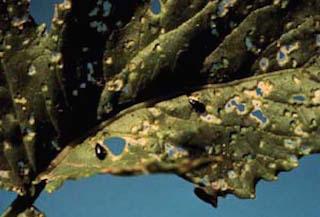
Cause
Flea beetles (various species).
Treatment
Fruit is rarely damaged. Treatment is usually not required. Control by eliminating weeds near field edges, and eliminating overwintering sites by removing crop residue.
Small circular holes in stems or leaf structures leading to tunneling and often wilting
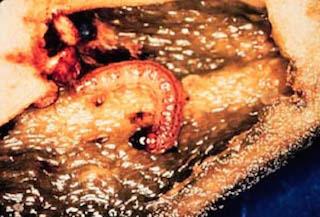
Cause
European corn borer (Ostrinia nubilalis), the larval stage of a moth. In most of Minnesota, only one generation occurs per year.
Treatment
Infected sites are sometimes difficult to spot until infestation is underway. Larva enter stems and fruit through small holes, then begin tunneling throughout the plant. Wilting and broken stems often follow this tunneling activity, and in the case of fruit, feeding damage is often followed by soft rot.
Pesticide treatments are difficult since the larva is only active outside the plant for a few days between egg hatch and tunneling activity--although labeled formulations of Bt and other pesticides are commercially available. Watch for flat white egg masses on leaf surfaces, or use black-light insect traps to scout for adult females in mid-June. Pesticides should be applied immediately after egg hatch, or 7 to 10 days after females begin to appear in June.
For additional control remove overwintering sites by eliminating crop residue from corn, pepper, potato, tomato, bean, and beet fields.
Chewing damage on leaf surfaces or fruit
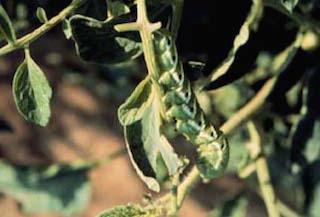 |
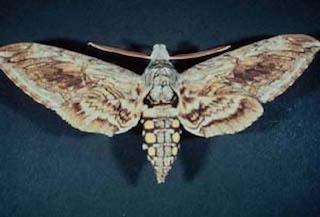 |
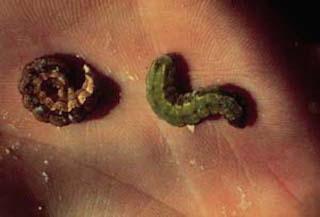 |
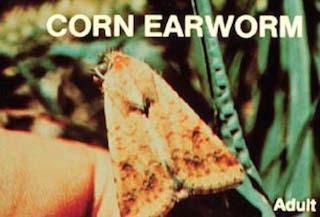 |
Cause
Caterpillars, various species including:
The corn earworm (Helicoverpa zea), up to 2 inches long and appearing in various colors--brown, green, or black with a light colored underside and alternating light and dark lines down the back. The tomato hornworm (Manduca quinauemaculata), larva of the "sphinx" or "hawk" moth. Larva are pale green with black and white markings and a large black protruding "horn" on the last abdominal segment. Late stage larva can reach 3 1/2 to 4 inches in length.
Feeding damage of these and other caterpillars is characterized by chewing of leaf or fruit surfaces sometimes accompanied by dark green or black droppings. Individual color patterns of caterpillars can vary, and the green color of many species makes them difficult to spot.
Treatment
Remove caterpillars by hand in small plantings. In large plantings, use approved formulations of Bt. Apply these pesticides when caterpillars are young and small if possible, and when populations exceed 0.5 caterpillars per plant.
Spots, Lesions, or Discoloration of Fruit, Leaves, or Stems
Irregular shaped spots, sometimes leaking fluid and often enlarging and becoming gray or purple
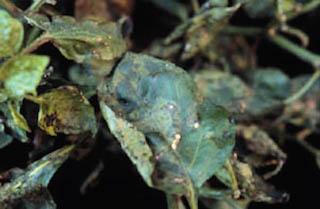
Cause
Bacterial leafspot (Xanthomonas campestris), a bacterial disease.
Treatment
This disease is spread by mechanical damage to plants during rainy or wet conditions. Few legal antibiotic treatments are available. To prevent infection avoid damage (such as caused by cultivation) to wet plants. Also rotate crops, avoid consecutive cropping of peppers, tomatoes, eggplant, or potatoes.
Large wounds often accompanied by dusty black spores
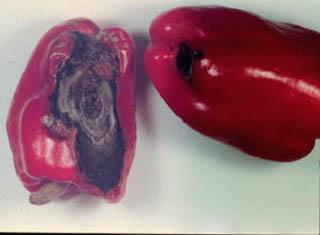
Cause
Alternaria solani, a fungal disease.
Treatment
Infection often occurs through sunscald damage. Therefore avoid any activity which causes leaf loss or damage to foliage.
Dry, light-colored lesions on the flower side of the fruit
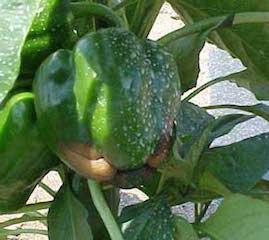 |
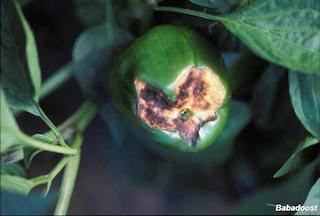 |
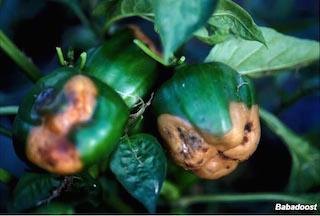 |
Cause
Blossom End Rot, a condition caused by drought conditions or calcium deficiency.
Treatment
Maintain adequate soil moisture, contact the U of M Soil Test Lab for recommendations, at 612-625-3101
Yellow or brown ring-shaped spots, or misshapen fruit or leaves
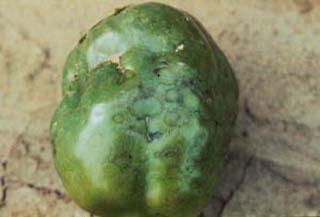
Cause
Viruses. May be accompanied by curled or misshapen leaves or fruit. Many viruses infect pepper including Tobacco Mosaic Virus, Tomato Spotted Wilt Virus, Cucumber Mosaic Virus, and many others. All are spread by insects or infected seed.
Treatment
Buy disease-free seed from a reputable source. Plant resistant varieties.
Yellow or brown leaves, often starting at the tips
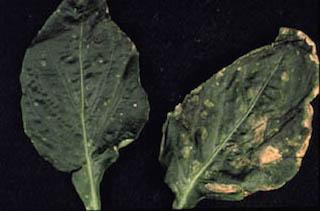
Cause
Abiotic (non-living) cause. Possible nutrient deficiency.
Treatment
Contact the U of M Soil Test Lab for recommendations, at 612-625-3101